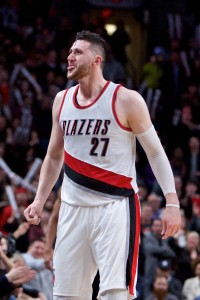After posting a 54-28 record in 2013/14, the Trail Blazers have found themselves slowly slipping down the Western Conference standings in recent years, with their win total declining from 54 to 51 to 44 to 41. Although the club earned a playoff spot last season, its 41-41 regular season record was a letdown.
The late-season arrival of Jusuf Nurkic provided a spark for the Blazers and gives the team a reason for optimism heading into the 2017/18 season. Since LaMarcus Aldridge‘s departure in 2015, Portland’s offense has been driven by its backcourt duo of Damian Lillard and C.J. McCollum, but if Nurkic recovers from his broken leg and continues playing like he did in his first 20 games with the Blazers (15.2 PPG, 10.4 RPG, 1.9 BPG), the team’s attack looks more balanced.
Still, while a full season with Nurkic in the lineup would bode well for the Blazers’ chances to improve, they won’t have it easy in a Western Conference that looks more daunting than ever. In Portland’s division alone, the Thunder added Paul George, the Timberwolves acquired Jimmy Butler, and the Nuggets signed Paul Millsap.
The Blazers, on the other hand, didn’t make any notable additions outside of rookies Zach Collins and Caleb Swanigan, who aren’t likely to make a major impact right away. Portland had to dump Allen Crabbe for nothing in order to cut team salary and reduce its projected luxury tax bill, giving the club one fewer outside shooter to rely on in 2017/18.
Despite Portland’s quiet summer and a loaded Western Conference, oddsmakers still project a very modest improvement for the Blazers this season, with offshore betting site Bovada putting the club’s over/under at 42.5 wins.
What do you think? Are the Blazers, with the help of Nurkic, set to bounce back and improve on last year’s record, or will they be hard-pressed to top 42 wins in a tough conference? Vote below and jump into the comment section to weigh in with your thoughts!
Trade Rumors app users, click here to vote.
Previous over/under voting results:
- Golden State Warriors: Over 67.5 (53.57%)
- Boston Celtics: Over 55.5 (63.5%)
- Houston Rockets: Over 55.5 (65.57%)
- San Antonio Spurs: Over 54.5 (67.74%)
- Cleveland Cavaliers: Over 53.5 (68.82%)
- Oklahoma City Thunder: Over 50.5 (71.77%)
- Minnesota Timberwolves: Over 48.5 (55.69%)
- Toronto Raptors: Over 48.5 (64.21%)
- Washington Wizards: Over 47.5 (71.29%)
- Milwaukee Bucks: Over 47.5 (63.88%)
- Denver Nuggets: Under 45.5 (50.44%)
- Los Angeles Clippers: Over 43.5 (60.7%)
- Miami Heat: Over 43.5 (55.39%)
- Charlotte Hornets: Over 42.5 (51.07%)
